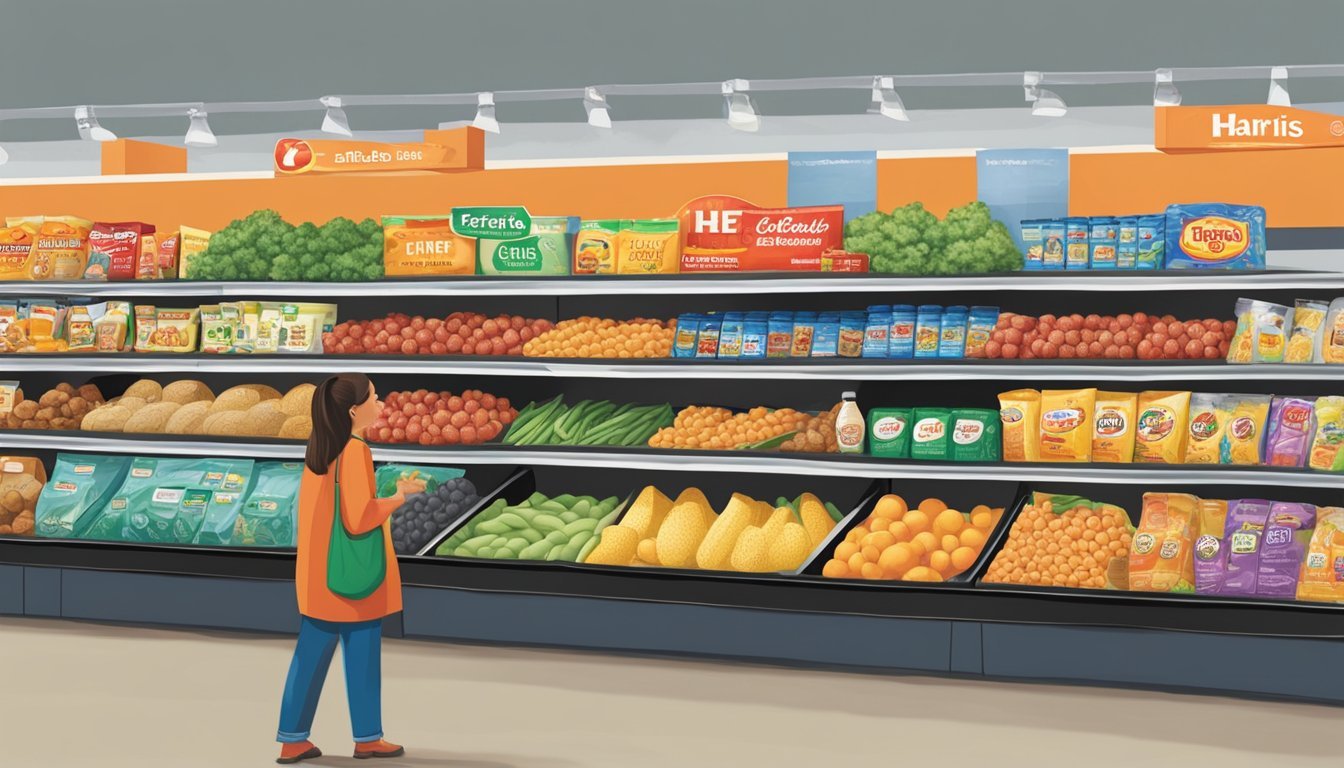Is H-E-B Cheaper Than Harris Teeter?
Comparing Southern Grocery Giants
Part of Our Grocery Store Guide with Details on H-E-B Prices and Harris Teeter Prices
When it comes to grocery shopping, price is often a key factor for consumers. The question of whether H-E-B is cheaper than Harris Teeter is one that many shoppers seek to answer as they aim to maximize their purchasing power. Both H-E-B and Harris Teeter are renowned for certain strengths in their offerings, which can translate into different pricing strategies across various product categories.
H-E-B is acclaimed for its wide selection of local products and fresh produce, which may contribute to the perception of its cost-effectiveness without compromising on quality. On the other hand, Harris Teeter is recognized for its extensive deli and prepared food section, which could affect its pricing. Analyzing the price points between these two stores necessitates a nuanced approach, taking into account the variety and quality of goods and services provided.
Comparisons of the two chains frequently involve a breakdown by specific categories such as dry goods, meats, and produce. For instance, Harris Teeter may offer more competitive prices in the dry goods category, which can make a noticeable difference in a shopper's budget. Such specificity in price comparison sheds light on where consumers might find the best value for their grocery lists, depending on individual shopping preferences and needs.
Overview of Grocery Store Landscape
The grocery store sector in the United States is a competitive arena where diverse chains like H-E-B, Harris Teeter, Walmart, and others vie for consumer loyalty through pricing, quality, and service.
Comparison of Grocery Chains
Walmart stands out as a key player with aggressive pricing strategies that often set the benchmark for affordability in the sector. It is common to see Walmart's prices being lower than many competitors, which can lead to significant savings for customers over time. Kroger, as the nation's largest grocery chain, leverages its scale to offer a competitive assortment of products, often focusing on digital sales to boost its market presence. Meanwhile, Target has been enhancing its grocery offerings to provide a one-stop shopping experience, often capitalizing on the convenience factor.
At the regional level, chains like Publix and Wegmans gain popularity through their focus on customer service and store brand quality, whereas companies like Aldi and Lidl disrupt the market with their no-frills, low-cost approach to retailing. On the premium end, Whole Foods Market, acquired by Amazon, is synonymous with high-quality organic and natural products, which come with a higher price tag. Safeway and Albertsons work to strike a balance between quality and value. H-E-B, especially, is noted for its commitment to community and emphasis on store brands for cost savings without sacrificing quality.
Role of Store Brands in Pricing
Store brands, or private labels, play a pivotal role in grocery store pricing strategies; stores use them to offer customers a lower-priced alternative to national brands. Retailers like H-E-B, Kroger, and Publix have invested considerably in developing their store brands, which are often priced below their national brand counterparts. This not only drives a better perception of value but also encourages customer loyalty. Walmart's Great Value and Target's up & up are examples of store brands that span a wide range of products, providing an economical choice that appeals to cost-conscious shoppers.
Price Factors in Grocery Shopping
When considering whether H-E-B is cheaper than Harris Teeter, one must take into account various elements that influence grocery pricing. These factors are critical in understanding the potential for savings at the checkout.
Determining Grocery Price Points
Grocery pricing is often determined by a combination of cost of goods, operational expenses, and competitive pricing strategies. Retailers evaluate the price they pay for items and add a markup to cover expenses and profit. They may also adjust prices based on what competitors are charging to ensure they offer attractive price points to consumers.
Cost of Goods: This includes the price retailers pay for products from suppliers.
Operational Expenses: Factors such as rent, utilities, and employee wages contribute to the final price of grocery items.
Competitive Pricing Strategies: Stores may lower prices on key items to draw customers in, hoping they will fill their baskets with other higher-margin products.
Influence of Location on Grocery Prices
The location of a grocery store can significantly affect the price of items due to transportation costs, real estate values, and local economic conditions.
Transportation Costs: The distance from suppliers can play a role in the final shelf price due to shipping expenses.
Real Estate Values: Stores in areas with higher property values may have higher prices to compensate for increased rent or mortgage payments.
Local Economic Conditions: Areas with higher average incomes or less price sensitivity might see stores setting higher prices.
Effect of Shopping Options on Savings
Shoppers can take advantage of various options to save money.
Coupons and Discounts: Utilizing store or manufacturer coupons can lead to direct savings on grocery bills.
Deals: Look for weekly deals and promotions to lower the cost of certain items.
Bulk Purchasing: Some categories may offer savings when items are bought in bulk.
It's important for consumers to consider these factors and shop strategically to maximize savings. The choice between retailers like H-E-B and Harris Teeter may come down to which store's pricing strategies align best with the shopper's budget and needs.
Comparative Analysis of H-E-B and Harris Teeter
When comparing H-E-B and Harris Teeter, the focus is often on the affordability, quality, and brand options each store offers. Understanding these factors helps customers make informed choices about where to shop for their grocery needs.
Item-by-Item Price Comparison
A thorough item-by-item price comparison between H-E-B and Harris Teeter indicates that prices can vary significantly depending on the product category. For example, H-E-B may offer a lower price on staple items such as bread and milk, while Harris Teeter might be more competitive with organic produce. However, these prices are subject to frequent changes due to promotions, regional pricing strategies, and member discounts.
Quality and Variety of Product Offerings
H-E-B prides itself on a broad variety of product offerings, with a particular emphasis on Texas-themed items and specialty products like their store-branded ice cream. On the other hand, Harris Teeter, which is a subsidiary of Kroger, also provides a diverse range of high-quality produce and personal care items. Both stores cater to a market that values quality, but H-E-B has built a strong reputation in Texas for its tailored product selection.
Store Brand Comparison: H-E-B vs. Harris Teeter
H-E-B's store brands, such as the H-E-B brand and Central Market Organics, are often appreciated for their price point and product quality. Harris Teeter, with its Harris Teeter brand and affiliation with the Kroger brand, similarly offers competitive pricing on its store brands. While H-E-B might lead in Texas-centric products, Harris Teeter’s store brands are also recognized for quality across various categories, including organic options and personal care.
Consumer Shopping Experience
When assessing whether H-E-B is cheaper than Harris Teeter, shoppers not only consider prices but also the overall shopping experience, which encompasses customer service, store atmosphere, and convenience.
Customer Service and Store Atmosphere
H-E-B is known for its excellent customer service and friendly store atmosphere. Employees are often praised for being helpful and courteous, assisting customers with their queries and purchases enthusiastically. The grocery chain strives to create a community feel within its locations, which resonates well with shoppers who often have specific needs, such as meal planning for a family of 4. Harris Teeter similarly provides a high level of customer service with staff ready to offer assistance, making grocery shopping less of a chore and more of a pleasant experience.
Convenience and Shopping Environment
Both H-E-B and Harris Teeter concentrate on offering a convenient shopping environment. H-E-B locations are designed with the customer's convenience in mind, with wide aisles and a well-organized layout that allows shoppers to quickly find what they need. Harris Teeter also boasts a clean and orderly shopping environment, often providing shoppers with an easy-to-navigate store layout conducive to efficient shopping trips. Additionally, both grocery chains have multiple locations, making them accessible to customers looking to purchase groceries without extensive travel.
Product Selection and Availability
When comparing H-E-B to Harris Teeter, attention must be paid to the range of products each store offers, particularly in the realms of fresh and frozen food selections. Shoppers are interested in a variety of options and the consistent availability of products.
Produce and Fresh Food Accessibility
H-E-B is renowned for its wide variety of fresh fruits and vegetables, including local Texan products like grapefruits and pecans. Customers often find a diverse selection of fresh produce like lettuce, tomatoes, and carrots, as well as a well-stocked deli with various meats and cheeses.
Fresh Produce Deli Selection Bananas Craft cheeses Potatoes Sliced turkey Organic salads Roast beef
Harris Teeter also provides a robust selection of fresh vegetables and fruits, dairy products, and an impressive deli section. Their fresh food access aligns closely with consumer demands for fresh meats including chicken, a variety of seafood choices, and a selection of organic produce.
Dairy Products Fresh Meats Milk Chicken breasts Eggs Ground beef Artisanal yogurts Salmon fillets
Assortment of Dry and Frozen Goods
At H-E-B, customers have access to an expansive selection of dry goods, from bread and cereals to pasta and spices. The frozen section complements this with a range of frozen vegetables, desserts, and convenience meals, ensuring a varied and comprehensive product assortment.
Dry Goods Frozen Foods Whole grain bread Frozen berries Brown rice Ice creams Canned legumes Ready-to-bake pizzas
Harris Teeter counters with competitive variety in its dry goods section, frequently offering larger packages which provide value for their price. The store ensures availability of staple items such as rice, flour, and powdered sugar. Their frozen food selection is extensive, with various brands offering frozen dinners, vegetables, and meats.
Bread Options Frozen Produce Multigrain loaves Peas & carrots Gluten-free options Mixed fruit Baguettes Vegetable medleys
Health and Safety Standards
When considering the health and safety standards of H-E-B and Harris Teeter, attention must be paid to their adherence to regulations and the efficacy of their recall procedures, which are designed to protect consumers and ensure the availability of healthy food options.
Compliance with Regulations and Standards
H-E-B and Harris Teeter are subject to strict health and safety regulations governed by the Food and Drug Administration (FDA), as well as local and state regulations. Both retailers must comply with a myriad of laws pertaining to various products including:
Food Safety: Ensuring all food products, including dietary supplements and healthy foods, meet safety standards.
Cosmetics: Guaranteeing that cosmetic products are free from prohibited ingredients.
Animal & Veterinary: Managing the safety of pet food and animal feed.
Biologics: For stores with pharmacies, ensuring the storage and handling of biologics comply with health standards.
They also must adhere to the guidelines set forth by the Occupational Safety and Health Administration (OSHA) to provide safe working conditions, and in some cases, the standards might align with international frameworks like ISO 45001 for the betterment of occupational health and safety.
Recall Procedures and Consumer Protection
In the event of a product recall, both companies use robust recall procedures to rapidly remove potentially harmful products from their shelves. H-E-B and Harris Teeter have systems in place to:
promptly access FDA's Product Recall Database;
identify and segregate products subject to recall efficiently;
notify consumers and ensure transparency regarding affected products.
Their procedures aim to minimize risks associated with:
Contaminated Food: Quick response to contamination incidents to prevent public health crises.
Mislabelled Products: Handling labeling errors, especially for consumers with allergies.
Both retailers prioritize consumer protection, maintaining trust by providing accurate information and taking swift action in response to safety concerns.
Cost-Effective Shopping Strategies
Consumers aiming for budget-friendly groceries can employ strategic planning and take advantage of discounts and loyalty programs. These approaches not only minimize costs but also maximize the value received from each shopping trip.
Maximizing Savings with Strategic Planning
When it comes to saving money on groceries, planning is essential. Before visiting H-E-B, Harris Teeter, or any other grocery store, customers should create a detailed shopping list centered on sale items and store specials. For example, purchasing shelf stable items like pasta, white rice, and brown sugar in bulk during a sale can lead to significant savings. Additionally, focusing on generic brands rather than name brands for products like flour tortillas and microwave popcorn can contribute to a lower grocery bill without sacrificing quality. Planning meals around discounted items, especially bulk purchases of cheddar cheese or sandwich bread, can further reduce expenses.
Utilizing Discounts and Loyalty Programs
Shoppers can save a considerable amount of money by using coupons and signing up for store loyalty programs. Both H-E-B and Harris Teeter offer digital coupons that can be easily accessed through their websites or mobile apps. Customers should target coupons for everyday items, such as peanut butter, sandwich bread, and raisins, to ensure they are saving on products they regularly use. Leveraging loyalty programs is another way to accumulate savings; members often receive exclusive discounts on various products and earn points that can be used for future purchases. For instance, purchasing cheddar cheese or flour tortillas with a member discount can add up to notable savings over time.
Conclusion
When comparing the prices between H-E-B and Harris Teeter, H-E-B often emerges as the slightly more affordable option. A study analyzing 38 grocery items found that H-E-B customers saved $2.04 over Walmart, suggesting that when pitted against Harris Teeter, savings could also be expected. While individual prices vary, the general trend indicates H-E-B's competitiveness in pricing.
Additionally, the comparison of competitors indicates that Harris Teeter typically has higher prices than Walmart and Food Lion, evidencing that Harris Teeter's pricing model may be positioned above some of its largest competitors. The decision to shop at H-E-B or Harris Teeter should not be based solely on prices, as both stores offer unique shopping experiences, product selections, and quality levels.
Consumers should also consider the value that each store provides. Harris Teeter's shopping experience and product quality are often highly rated, even if their prices are not the lowest. In some instances, Harris Teeter offers better value per unit, even when their total prices were higher, as indicated by the meat section comparison with Ingles.
Summary:
H-E-B: Provides lower prices on several items.
Harris Teeter: Offers perceived value through quality and shopping experience.
In conclusion, budget-conscious consumers may prefer H-E-B for routine grocery shopping due to its competitive pricing, while those who prioritize a wider selection and premium products might lean towards Harris Teeter, despite potential higher costs.







